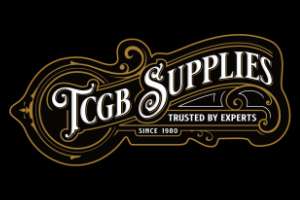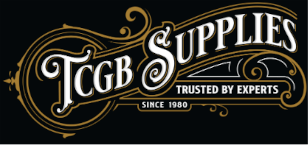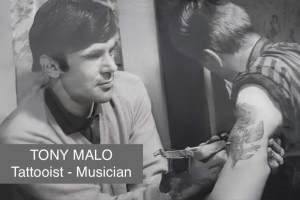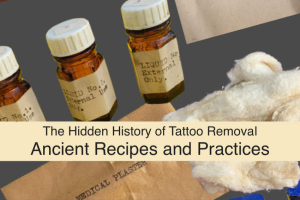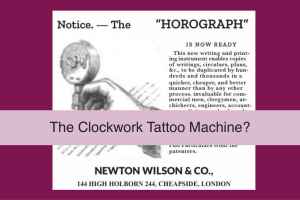Tony Malo: Tattooist, Musician, and Artist
Tony Malo, also known as Toni Malo, was a man driven by creativity and passion. His wide-ranging interests took him from tattooing to music, and from running curiosity shops to exploring different artistic avenues. Born on August 25, 1937, Tony’s life was a blend of talent, determination, and an entrepreneurial spirit that left a mark on everything he touched.
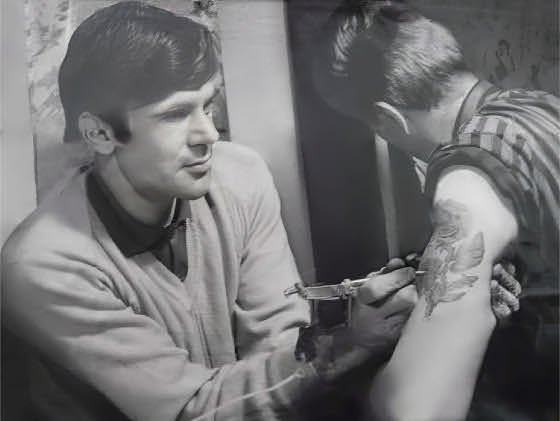
Early Life and Tattooing Beginnings
Tony’s journey into tattooing started when he was just 14 years old, back in 1951. After getting his first tattoo, he was immediately captivated by the art form. Fascinated by the tattoos he saw and eager to know more, Tony started seeking out whatever information he could find. His passion for the craft never faded, and he soon began teaching himself the intricacies of tattooing. By the early 1960s, he had turned his newfound skill into a profession when he opened a tattoo studio in Oxford.
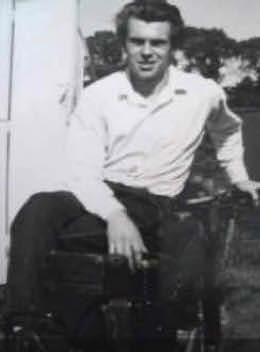
Tattooing was still a relatively niche practice back then, much less common than it is today. Tony’s clients were often part of the "Rockers" subculture, who would get tattoos to mark their affiliations. His early work was well-known among these groups, and stories of his artistry were shared by his brother, Phil Williams, and even captured in a mid-1960s newspaper article. Tony worked from two locations: one at 93 or 95 Oxford Road, Cowley (now the Motorists Discount Centre, which has since expanded into all the previous shops). Older staff at the Motorists Discount Centre recalled the boss mentioning that tattooing gear was found in the loft when the original shop was extended into the other two. The other location was at 4 The Plain. Next door to his studio at 5 The Plain was Clark's (Oxford) Ltd, a busy motorcycle shop that was a Velocette dealer, making it a prime location frequented by motorcyclists. This proximity helped attract a steady stream of customers, many of whom were part of the local "Rockers" scene. However, as tattooing slowed down in the late 1960s and the rise of alternative subcultures diminished the demand, Tony decided to put away his needles and explore new ventures.
The Curiosity Shops
In the 1970s, Tony shifted his focus to running a secondhand and curiosity shop on London Road in Headington, Oxford. The shop, featuring buffalo horns mounted above the door, was a reflection of Tony’s taste for the quirky and unusual. In the summer of 1973, Lionel Titchener happened to be passing by Tony’s shop and decided to have a look around.
During his visit, Tony noticed a dressing on Lionel’s arm, which he recognized as covering a fresh tattoo. Their conversation quickly turned to tattoos, and Tony mentioned that he had some old tattoo equipment he wanted to sell. Intrigued by the equipment and the mystery of tattooing, Lionel decided to buy it and see if he could use it. He left a deposit and returned a week later to pick it up. True to form, Tony added a few extra items to the collection and slightly increased the price—a small example of his sharp business instincts and sense of humor.
By the mid-1970s, Tony had remarried (to his third wife, Valerie Cross) and moved to the Isle of Wight. He opened another curiosity shop, Ancient and Modern, at 3 Mill Hill, Cowes. Like his previous ventures, the shop was a mix of antiques and oddities, reflecting Tony’s knack for finding unique items and his flair for entrepreneurship. The items arranged on his CD sleeve On the ROCK were some of the unusual items he had collected.
Watch Tony Malo performing on stage in the Isle of Wight, showcasing his musical talent and love for the local folk scene:
A Return to Tattooing
Though he’d stepped away from tattooing for a while, Tony couldn’t resist the pull of the craft. In the 1980s, he set up a small tattoo studio behind his shop on the Isle of Wight, marking his return to the art form that had originally sparked his creative journey. This return felt like a natural progression, combining his love for craftsmanship with his ability to connect with people.
Music and the Isle of Wight Folk Scene
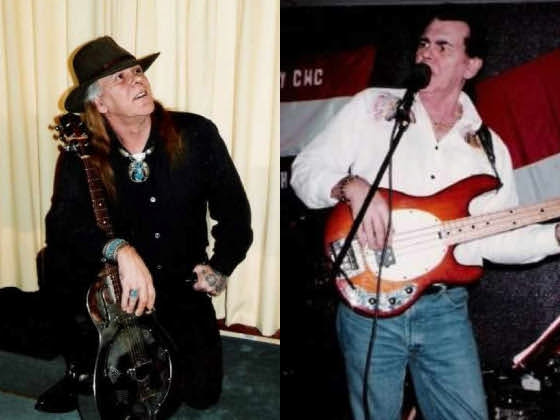
Tony wasn’t just a talented tattoo artist; he was also an accomplished musician. He taught his younger brother, Phil, how to play the guitar when he was just 11 years old, sparking a shared love of music between them. By the mid 1970s, Tony had become an important figure in the Isle of Wight’s folk music scene. In 1976, he released a 7-inch single titled The Ferry to the Isle of Wight / Cowes Week on Solent Records.
The A-side, Cowes Week, paid tribute to the island’s iconic sailing regatta, while the B-side humorously poked fun at the outdated ferry services. The single became a local favorite, earning attention from national newspapers like the Daily Mirror and Daily Express. Later, The Ferry to the Isle of Wight was remastered for the compilation Songs from Singing Islanders, and today, the song can still be found online, continuing Tony’s legacy within the Isle of Wight’s cultural scene.
Family, Legacy, and Artistic Ventures
Tony’s creativity extended beyond his own work and into his family connections, including a notable relation to Rod Evans, the original lead singer of Deep Purple. This familial tie added another layer to Tony's rich artistic world, blending his love for music with a wider cultural influence. In addition to his involvement in tattooing and music, Tony ventured into visual arts and publishing. In 1992, he authored The Art of Bondage Art, No. 1, a niche publication that showcased his bold approach to unconventional themes and artistic expression. He also wrote The Sword and the Slave: Book One, part of the Olympia Pillow Book series, reinforcing his reputation as a versatile and daring artist.
Tony's life was filled with remarkable encounters and experiences. He tattooed notorious figures such as Richard Speck, the infamous mass murderer, and shared a prison cell with Christopher Craig. Tony also crossed paths with legendary figures, such as being kissed by Marilyn Monroe and befriending comedian Jethro and poet Pam Ayres. He was offered a film part alongside his father at Pinewood Studios, but both men turned it down—only for the role to go to a young David McCallum, who later became famous for his role in The Man from U.N.C.L.E..
Tony’s adventurous spirit led him to an encounter with Albert Pierrepont, the famed executioner, who showed Tony the hanging room in prison, a moment that deeply impacted him. He also taught actor Robin Asquith to water-ski and had connections with gangster Billy Hill, adding yet more fascinating layers to his colorful life.
Tony’s legacy lives on through his family, particularly through his nephew, Dan Williams, whose body is now covered with tattoos inspired by Tony’s final album On the Rock. This album was Tony’s last hurrah, and its influence endures in Dan’s tattoos, which he continues to have added by a local tattooist in Redruth, Cornwall.
A Lasting Legacy
Tony Malo passed away on 4th May 2005, but his creative spirit continues to live on. His brother Phil, who keeps Tony’s ashes in an urn adorned with a soaring eagle, fondly remembers their bond. “Tony hated being in the wind and rain, so he’s with me in a suitable urn,” Phil says, a fitting tribute to his brother’s character.
Tony’s life was a celebration of passion, creativity, and connection. From his tattoos and music to his shops and artistic projects, he left behind a lasting legacy that continues to inspire those who knew him. Tony Malo’s story reminds us that creativity has no limits, and that one person’s passions can touch and inspire many lives
This article draws on the memories of Phil Williams, Tony’s brother. Phil often reflects on the many remarkable stories that flood his mind when he thinks of Tony—the incredible people Tony met and the adventures he had, all of which made his life truly one-of-a-kind.
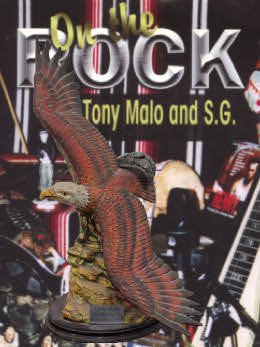
Phil Williams, Tony's brother, keeps Tony’s ashes in an urn adorned with an eagle—a fitting tribute to Tony's free-spirited nature and creative talent.
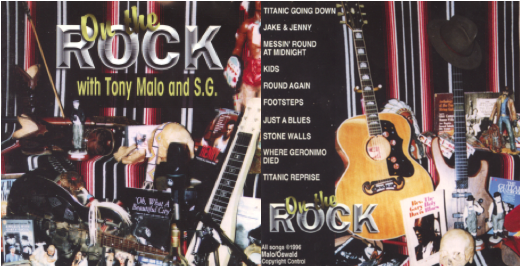
As Tony Malo's journey continued, his creative pursuits evolved beyond tattooing and into a deeper exploration of music, writing, and personal reflection. The following details from the On the ROCK CD label offer a glimpse into his musical career and the personal experiences that shaped his artistic legacy. From early performances with well-known artists to moments of introspection, these reflections highlight the diversity of his artistic journey.
Tony began playing guitar in the mid-1960s, focusing primarily on acoustic blues. He performed alongside celebrated artists such as Jo Ann Kelly, Gordon Giltrap, Savoy Brown, and Jethro Tull, and even supported iconic bands like the Rolling Stones and Pink Floyd at two Rag Balls. His musical lineage was also notable, being the first cousin of Rod Evans, the original lead singer of Deep Purple.
In the Oxford area, Tony fronted a rock band called Traction, performing a mix of cover songs and originals. The band had reasonable success until they lost their drummer, who went on to join Mr. Big. Seeking new horizons, Tony moved to the Isle of Wight in 1974, where he recorded a single in 1976 with Solent Records. He continued to perform locally as a solo artist before joining the popular island country band 'Detour' as their bass player, a band that is still active today.
After years of working in music, Tony took a five-year hiatus from the industry while working as a professional snooker coach across Europe. During this period, he also ventured into writing, producing four novels with dark, violent themes that later gained attention from the underground press in the U.S. His time at J. Arthur Rank Studios, where he worked with Hollywood legends like Marilyn Monroe, Rod Steiger, Burt Lancaster, and Tony Curtis, also influenced his creative outlook.
Despite his diverse ventures, Tony always remained reflective about his past. He humorously acknowledged his failed marriages, his time spent in various institutions, and his evolving musical career. His early love for poetry and his influences from figures like Leonard Cohen and Bob Dylan shaped his songwriting. Though his voice was worn down after years of rock performances, he continued to write and play, earning appreciation from his listeners.
Ultimately, Tony’s collaboration with guitarist Phil Oswald and sound engineer Martin White helped bring his music to life. With their support, Tony’s raw ideas were turned into fully realized tracks, and he expressed deep gratitude for their faith in his work. These recordings marked a significant chapter in his life, and he was pleased with the final result, thankful for the opportunity to see his music through to completion.
Special thanks to Phil Williams for kindly providing the photographs featured in this article.
Links
"Songs From Singing Islanders"
In 1976, Tony Malo was the star of the Isle of Wight’s folk scene, delivering a hit song about Cowes Week, paired with a playful jab at the outdated ferry services. This 7" single, recorded in John Waterman's front room in STEREO!, became the summer hit of the Isle of Wight, garnering attention in national newspapers such as the Daily Mirror and Daily Express.
Solent Records - An independent label from the Isle of Wight
The Ferry to the Isle of Wight / Cowes Week - Solent Records.
Solent Records, once based in Cowes, Isle of Wight (PO31 7HJ), ceased operations 45 years after its founder, John Waterman, retired.
Toni Malo – The Ferry To The Isle Of Wight / Cowes Week
This 7" vinyl single from Solent Records (SS 043), released in 1976, features sea shanties in the Folk, World, & Country genre. Available through record dealers. Check out the link above for more details and to view the album cover and other images.
